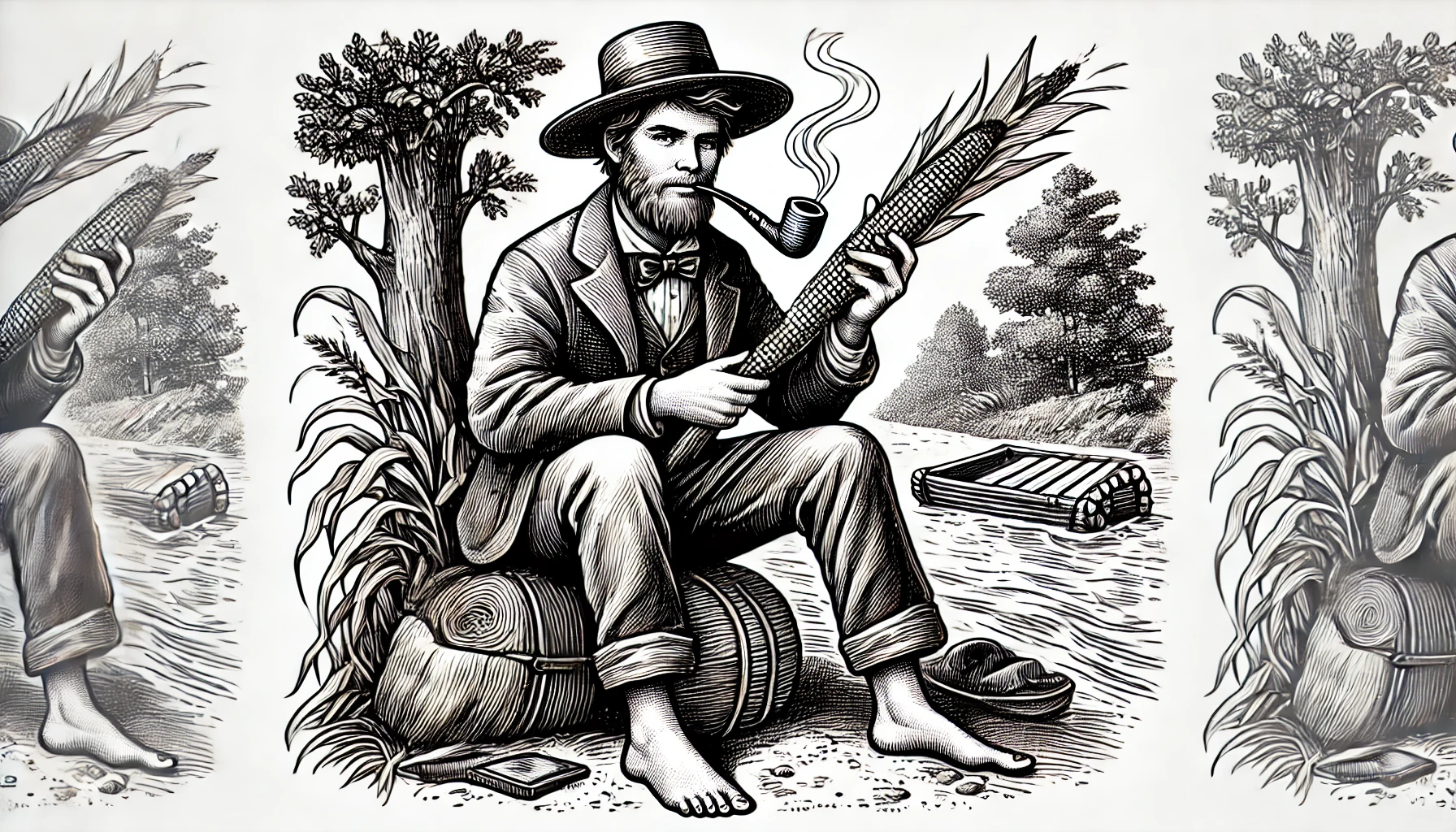Google Images Huckleberry Finn Illustrations Corncob [Pipe
Introduction:
Mark Twain’s Adventures of Huckleberry Finn is one of the most beloved works in American literature. The tale of young Google Images Huckleberry Finn Illustrations Corncob [Pipe Huck and his journey along the Mississippi River is filled with adventure, social commentary, and moments of reflection. Alongside Twain’s iconic storytelling, the illustrations accompanying this work have played a significant role in shaping how readers envision the characters and setting. One particularly distinctive element seen in many of these illustrations is Huck’s use of a corncob pipe. In this blog, we will delve into how Huckleberry Finn illustrations have evolved over time, focusing on the unique depictions of Huck, especially as showcased in “Google Images Huckleberry Finn Illustrations Corncob [Pipe.”
The Role of Illustrations in Classic Literature
Illustrations in classic literature provide a visual element that enhances the reader’s imagination. For Huckleberry Finn, these illustrations have evolved over the years, but certain aspects, like Huck’s signature corncob pipe, remain constant. Whether rendered in black and white sketches or colorful modern depictions, the corncob pipe has become symbolic of Huck’s carefree and rebellious nature.
Through “Google Images Huckleberry Finn Illustrations Corncob [Pipe],” one can trace how artists have interpreted Huck’s character over time. In this blog, we’ll explore the historical significance of the corncob pipe in the illustrations, its impact on Huck’s portrayal, and how these images reflect the changing cultural landscape.
The Evolution of Huck’s Corncob Pipe in Illustrations
Early Depictions of Huck Finn
When Huckleberry Finn was first published in 1884, the illustrations reflected the style of the time, with detailed engravings that captured the rustic, rough, and adventurous spirit of Huck. One of the defining features in these early illustrations is Huck’s corncob pipe, often used to emphasize his independence and rebellious nature.
The corncob pipe itself is a simple, almost iconic object that visually represents Huck’s connection to a more rural, down-to-earth lifestyle. In Google Images Huckleberry Finn Illustrations Corncob [Pipe], many early illustrations emphasize this simplicity, portraying Huck with a ragged appearance, barefoot, and often holding or smoking his corncob pipe. These early images align closely with the narrative of Huck as a poor boy who prefers freedom to societal constraints, making the corncob pipe an extension of his untamed spirit.
Moreover, in these early illustrations, Huck is often depicted against the backdrop of rural America, reinforcing his connection to nature and simplicity. His corncob pipe, in these scenes, adds to his image as an independent boy, unfazed by the demands of society. It’s important to note how these early depictions present Huck’s pipe as an essential part of his personality rather than a mere accessory.
Mid-20th Century Illustrations
As the years went by, Huckleberry Finn illustrations began to reflect the changing art styles of the 20th century. The imagery became more polished, with bold lines and detailed backgrounds. However, Huck’s corncob pipe remained a constant feature in these illustrations, signaling continuity in how artists have chosen to depict the character.
In this period, the illustrations captured a more nuanced portrayal of Huck, with the corncob pipe serving as a symbol of his maturity and wisdom gained through his adventures. Artists often used the pipe to depict Huck as a thinker, pondering the moral complexities of his journey. The pipe, therefore, evolved from a symbol of rebellion to one of reflection, a transformation that paralleled Huck’s development throughout the story.
In Google Images Huckleberry Finn Illustrations Corncob [Pipe], examples of mid-20th-century artwork often show Huck seated by the fire or looking contemplatively over the Mississippi River, pipe in hand. These images emphasize Huck’s transition from a carefree boy to a young man shaped by the experiences and moral dilemmas he encounters on his journey. The corncob pipe, once a symbol of rebellion, now takes on new meaning, reflecting the maturity Huck gains along the way.
Modern-Day Illustrations
In more recent years, as seen in “Google Images Huckleberry Finn Illustrations Corncob [Pipe],” modern-day illustrators have embraced vibrant colors, dynamic poses, and even digital illustrations to depict Huck Finn. While the corncob pipe remains, its presentation often varies, sometimes as a central feature, other times as a subtle nod to the character’s roots.
Contemporary artists tend to focus on Huck’s emotional journey, and the corncob pipe is often seen as a relic of his old life, symbolizing his growth from a carefree boy to someone who has grappled with significant life challenges. In these illustrations, the pipe serves more as a nostalgic reminder of Huck’s beginnings, while also connecting modern audiences to the historical context of the character.
The rise of digital art platforms has allowed illustrators to experiment with the depiction of Huck and his corncob pipe in ways that were previously unimaginable. Vibrant colors and bold contrasts are often used to draw attention to Huck’s corncob pipe, either as a focal point or a more subdued detail. This artistic flexibility has allowed for the corncob pipe to remain relevant in Google Images Huckleberry Finn Illustrations Corncob [Pipe], even as artistic styles and preferences continue to evolve.
Symbolism of the Corncob Pipe in Huck’s Character
The corncob pipe, while seemingly a small detail, holds significant meaning within Huck’s characterization. Representing both his rebellious spirit and his connection to the common folk, the pipe symbolizes Huck’s desire to live outside the rules of society.
Through “Google Images Huckleberry Finn Illustrations Corncob [Pipe],” we can see how this seemingly simple object helps define Huck’s identity. The pipe is not just a prop; it’s an extension of Huck’s personality—his independence, free-spiritedness, and refusal to conform to societal expectations.
Many illustrators have used the corncob pipe to contrast Huck with other characters. While figures like Tom Sawyer are often depicted with more refined appearances, Huck’s rustic look, complete with the corncob pipe, emphasizes his role as the outsider and nonconformist. The pipe underscores his willingness to take the road less traveled, both literally and figuratively.
The symbolism of the corncob pipe extends beyond Huck’s personal identity. In many ways, the pipe reflects larger themes within the novel—freedom, resistance to authority, and the tension between civilization and nature. Huck’s corncob pipe, which is often associated with rural, working-class Americans, serves as a visual reminder of the values Huck holds dear, even as he navigates the complexities of society and morality.
How Google Images Reflects Changes in Artistic Depictions
“Google Images Huckleberry Finn Illustrations Corncob [Pipe]” offers a unique opportunity to see how artistic interpretations have shifted over time. As new generations of artists have taken on the challenge of visualizing Twain’s world, their interpretations reflect both historical and contemporary influences.
In some illustrations found on Google Images, Huck’s corncob pipe is rendered in highly realistic detail, while others adopt a more abstract approach, focusing on the pipe as a symbolic element rather than a literal object. These variations showcase how artists continue to find new ways to tell Huck’s story, even as they remain faithful to certain iconic elements like the corncob pipe.
As you browse through the results of “Google Images Huckleberry Finn Illustrations Corncob [Pipe],” it’s clear that the corncob pipe remains one of the most enduring symbols associated with Huck Finn. Whether rendered as a central feature of the illustration or as a subtle detail, the corncob pipe serves as a thread that connects Huck’s various depictions across time.
The Importance of Corncob Pipe in Huck’s Iconography
The corncob pipe has become so intertwined with Huck’s image that it’s almost impossible to imagine him without it. This is especially evident when looking at the vast array of illustrations found in “Google Images Huckleberry Finn Illustrations Corncob [Pipe].” It’s a symbol that has persisted through the ages, from the earliest woodcut illustrations to modern digital artwork.
The pipe serves as a visual shorthand for Huck’s character, representing his nonchalant attitude towards societal norms and his journey towards self-discovery. In many illustrations, the corncob pipe is depicted as an essential part of Huck’s daily life, whether he’s rafting down the Mississippi or sitting by a campfire. It reflects his independence, his willingness to live on his own terms, and his sense of adventure.
Artists have used the corncob pipe to emphasize different aspects of Huck’s character. Some focus on his playful, mischievous nature, portraying him with a grin and a loosely held pipe. Others highlight his contemplative side, depicting Huck deep in thought, with the pipe serving as a symbol of the wisdom he’s gained from his experiences.
How Artists Interpret Huck and His Corncob Pipe
The beauty of Huckleberry Finn illustrations lies in the diversity of artistic interpretations. From detailed, realistic renderings to more stylized, modern depictions, the variety seen in “Google Images Huckleberry Finn Illustrations Corncob [Pipe]” showcases the creativity of artists who have taken on the challenge of bringing Huck to life visually.
Some illustrators choose to emphasize Huck’s carefree, childlike nature, portraying him with a mischievous smile and a loosely held corncob pipe. Others highlight his more contemplative side, showing Huck lost in thought, the pipe symbolizing the maturity and wisdom he gains over the course of his adventures.
The range of artistic styles found in “Google Images Huckleberry Finn Illustrations Corncob [Pipe]” is a testament to the enduring appeal of Twain’s story. Each artist brings their unique perspective to Huck and his iconic corncob pipe, ensuring that the character remains relevant to new generations of readers. Whether drawn in the traditional style of early illustrations or rendered in bold, modern colors, Huck and his pipe continue to capture the imaginations of readers and artists alike.
Conclusion:
The illustrations of Huckleberry Finn are as timeless as the story itself. Through the years, Huck’s image has been shaped and reshaped by countless artists, each bringing their unique vision to this beloved character. Yet, through all these interpretations, Huck’s corncob pipe has remained a constant, a symbol of his independence, his connection to the common man, and his refusal to be confined by societal norms.
As we’ve seen in this exploration of “Google Images Huckleberry Finn Illustrations Corncob [Pipe],” the depictions of Huck and his corncob pipe are as diverse as the artists who create them. But one thing remains clear: Huck’s story, and the images that accompany it, will continue to captivate readers and artists for generations to come.



![https://i.pixxxels.cc/sdbpbtgr/images.jpg[/img]](https://bigmagazinenews.com/wp-content/uploads/2024/09/Untitled-design-5-768x427.png)


